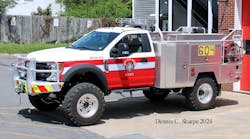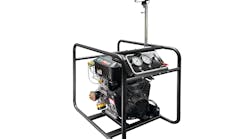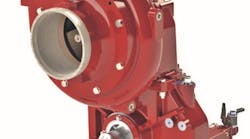When it comes to fire apparatus front-bumper configurations, they’re like blank canvases limited only by one’s imagination and pocketbook.
Bumpers can range from a functional painted piece of steel to 30-inch polished stainless and diamond-plate platforms for the mounting of everything from hoselays, or winches, to hydraulic extrication tools, simple lights and sirens and everything in between.
“It all depends on what the customer wants,” said James Maddy, the engineering manager of the chassis division of Sutphen Corporation, a custom fire apparatus builder with headquarters in Amlin and Dublin, OH. “We do them differently for each customer.”
Firehouse spoke with manufacturers to learn more about the do’s and don’ts of front bumper design and learned that front bumpers can do a lot more than just protect the apparatus and the souls who ride in them.
Overall apparatus length
"(Firefighters) are always looking for additional storage capabilities,” said Bruce Nalesnik, chassis group product manager for KME Fire Apparatus, based in Nesquehoning, PA, and a part of the REV Group. “They want to be able to put more and more in them. They certainly aren’t getting any simpler.”
Both Maddy and Nalesnik said the first item firefighters should consider when making bumper selections is overall apparatus lengths. The bumper counts when it comes to length and the last thing anyone would want to do is specify an apparatus that is too long for the station.
“We’ve had a few departments say they want everything and then they call back when they realize it won’t fit in the station,” said Mike Burrell, design engineer for Sutphen’s cab and chassis division.
Nalesnik said departments that decide they want a huge front bumper extension might have to compromise and shorten the body or pump panel configuration to meet overall length requirements.
“Something may have to be shortened, somewhere,” he said.
Another key factor in determining the length the extension can be is the grade of incline the apparatus is expected to travel.
Nalesnik said fire departments need to look at their entire area of response when considering bumper lengths. If there’s one region, or spot in the response area with a steep angle of approach, which may impede the bumper travel, they should reduce the length or make some concession to make sure the apparatus can go everywhere it’s needed.
Maddy said he sometimes sees departments trying to put too much stuff on a bumper and running into trouble as a result.
“It’s like the old saying they’re trying to put 10 pounds of stuff in a five-pound sack,” he said. “Sometimes you just can’t make it.”
Surprisingly, there are no real weight restrictions on the front bumper, which puts the load in front of the front axles, Burrell said, noting that even fully loaded bumpers only add a few hundred pounds to the overall weight of the vehicle.
Strength and stability
Burrell said the real function of a bumper is to protect the vehicle and its occupants, so strength has to be a priority. He noted that when a collision between a fire truck and a car occurs, rarely is there any substantial damage to the truck.
“Bumpers have to be strong,” Burrell said. “If they need to push vehicles out of the way to get to a scene, they can.”
Nalesnik said a trend he’s seen at KME is the addition of a horizontal reinforcement behind the front bumper, underneath the gravel shield on larger, heavier extensions. He said it’s often a piece of angled steel running side to side to provide additional stability.
He also cautioned that departments shouldn’t overbuild the bumper.
“Don’t feel you need to add bulk to a front bumper creating in effect a battering ram,” Nalesnik said. He added that the front bumper extension and drop frame assembly on fire apparatus should be designed to absorb the energy of an impact, reducing the transfer of all the frontal impact to the cab and its occupants.
Material matters
As a custom builder, Sutphen tries not to say no to its customers Burrell said, but there has to be a point when safety and practicality prevails.
Sometimes there’s just too much stuff that interferes with each other and the mechanics of the apparatus, Burrell said.
For instance, a front bumper winch requires a steel structure under the bumper onto which the winch is bolted, Burrell said, noting that might make it challenging to locate pump discharges and intakes, and reels for extrication tools or power cords.
“There are a lot of interfaces on the front bumper,” Burrell said.
If the bumpers have diamond plate covers, the height should not interfere with the tilting of the cab, Maddy said.
Sutphen, like many builders, notches angles into the back corner of the cover to accommodate the cab when it needs to be lifted, Maddy said.
Burrell said Sutphen conducts a “finite analysis” of bumper designs to make sure there’s no interference with cabs or headlight beams and that all components will work together as designed.
Normal material for bumpers are either painted steel or polished aluminum for a bright appearance, Maddy said. Burrell noted that Sutphen has used a wide variety of color on bumpers from neon green to purple, blue, pink and everything between.
A new trend is blacked out, where anything that could normally be bright work is painted with a black matte finish, Maddy said. The grit in the matte finish provides some slip prevention on stepping surfaces, he said.
At KME, Nalesnik has seen a similar black-out trend, but cautions customers that the matte finish can be difficult to clean and may not look as sharp as the customer thought even after the first person steps on it with muddy boots.
Nalesnik said he’s noticed a “marked shift” to painted steel bumpers.
“We’re seeing a lot of fabricated steel bumpers,” he said, adding that painted steel is cheaper than polished stainless, which can be a $1,000 upcharge. He also said painted steel is easier to repair should it be damaged and there’s a perception of strength and durability as well, although the polished stainless still is very strong and durable itself.
And when it comes to finishes, Maddy said Sutphen coats the bracketry and hardware under the bumper with zinc-primer to help prevent corrosion.
“Everything is pretty open and exposed under there,” Maddy said, noting that’s why corrosion control is important to consider.
Pricing and packaging
Another feature that Sutphen has in its front bumper is the manual jack for tilting the cab, Maddy said, noting its location makes it more accessible than some other manufacturers.
Cost is a factor in making bumper choices Nalesnik said, noting that bumper upgrades can cost from $5,000 to $10,000 and more depending on the equipment up fit.
At KME, Nalesnik said they try to offer some basic packages to maintain costs and help guide customers.
Some of the packages offer front suctions and discharges with a variety of storage wells. Nalesnik said departments considering front suction should look at the option of coming straight out of the bumper, which eliminates the need for a swivel elbow and could save money and actually make the truck a little shorter.
There are also options for bumper cover material, he said, noting there’s more than tread plate available. Hypalon fabric is another option as are straps to hold equipment in place.
Nalesnik also said departments can look at options like one air horn and one siren speaker instead of two as other ways of saving money.
A sometimes overlooked front bumper feature is the tow hooks and eyes, Nalesnik said. Those specifying apparatus should realize that the way apparatus is lifted and towed for transported for repairs should be considered when developing the specs. Some hooks and eyes are below the bumper, others protrude out and, in all cases, they need to be factored into the design to avoid interference, he said.
“It all comes down to packaging,” Nalesnik said. “They want to put all this stuff in the bumper and we do the best we can to accommodate their requests. …It’s all about choices.”








